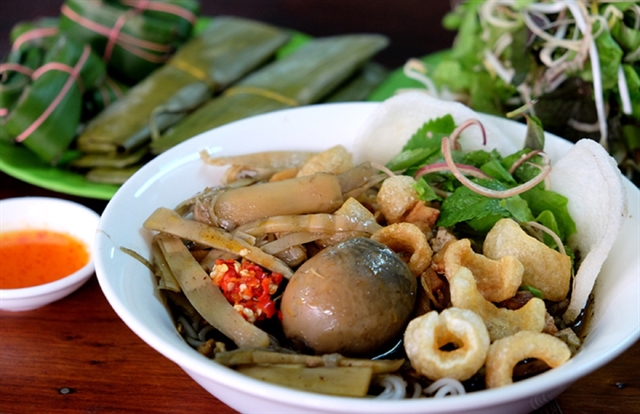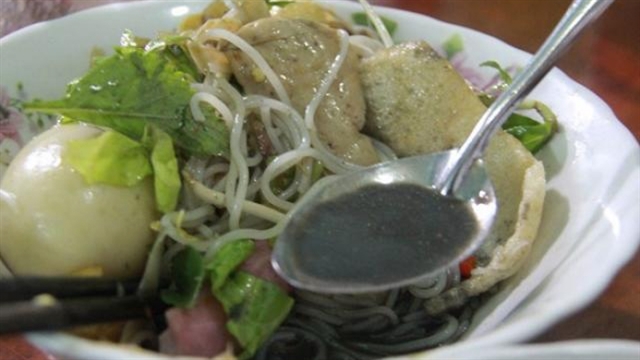 Sports
Sports

Visitors to Pleiku City in the Central Highlands province of Gia Lai will often hear about the popular dish bún mắm cua (rice vermicelli soup with crab sauce), but many do not dare to try it because of the pungent odour. However, those who do are addicted by the taste and keep coming back for more.

|
| Bún mắm cua in the Central Highlands Province of Gia Lai. — Photo baogialai.com.vn |
By Lâm Giang
Visitors to Pleiku City in the Central Highlands province of Gia Lai will often hear about the popular dish bún mắm cua (rice vermicelli soup with crab sauce), but many do not dare to try it because of the pungent odour. However, those who do are addicted by the taste and keep coming back for more.
The main ingredient is obviously rice field crab. Several kilos of crabs are washed and crushed after their shells are removed. This is then strained in water and fermented for 24 hours.
The water turns black and gives off a strong smell.

|
| The main ingredient of bún mắm cua is ricefield crabs. — Photo eva.vn |
To make the dish more attractive, cooks slice fresh or dried bamboo shoots and add them to a pot of boiling crab on a low fire.
According to Châu Thị Chi, the owner of Quán Chi on Phùng Hưng Street, to make the dish, people must use live crabs from Gia Lai, because they're the best around.
Chi said bún mắm cua has been popular in Gia Lai for a long time, thanks to the abundance of freshwater crabs.
In the old days, people didn’t have much to eat, so they caught crabs to grind and cook in brine to preserve them before chowing down with a bowl of noodles.
A bowl of bún mắm cua includes vermicelli, bamboo shoots, deep-fried pork skin, fried onions and crushed peanuts, topped with crab.
The dish changes in each area. People can add a duck egg or meat, but it is still served with fish sauce and spicy chilli peppers to enhance the flavour.
Diners can also enjoy bún mắm cua with spring rolls and fresh vegetables.
Locals often eat two or even three bowls to satisfy their cravings.
“I often eat several bowls of bún mắm cua when I visit this stall. Yesterday I ate here and today I'm eating here again,” said Trần Thị Thành, who was born in Pleiku but lives in Đà Nẵng.
“Many people say the dish has a strong smell but I'm used to it and love how tasty it is,” Thành added.
Nguyễn Văn Thành, a visitor to Pleiku, said: “I found the dish to satisfy my curiosity. My friends said bún mắm cua was a must-try specialty, and although it might sound horrible, just trying it once would get me hooked, so I had to try. I only intended to try it once but then I changed my mind,” said Thành.
“I've tried to find it in Hà Nội, and now I am a bún mắm cua addict,” Thành said with a smile.

|
| Bún mắm cua has been around for a long time in Gia Lai, where there are many freshwater crabs. — Photo eva.vn |
At famous food stalls like Quán Chi, the owner must use around 20kg of fresh crabs to serve customers every day.
Chi, 52, opened the stall in 1998 in the mountainous city.
“I started off as a street vendor, but then I found a comfortable space for customers to enjoy,” said Chi.
Bún mắm cua is a rare speciality of Pleiku and the Central Highlands.
If you are brave to overcome your fears, this dish will leave you with a memorable experience. VNS




